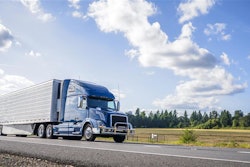
The loading dock is an essential part of any manufacturing company, warehouse or distribution center. It’s what allows the process of raw materials to enter and completed goods to be transported to consumers and end users. Unfortunately, the loading dock can be a hazardous environment where accidents can occur. It is estimated that 25% of all industrial accidents happen at the loading dock, according to ISHN.
Organizations often invest in loading dock safety systems to mitigate the risk of accidents or injury at the loading dock. A variety of systems can be found on the market to prevent these incidents such as hook restraints, wheel chocks, blocking arms and interlocking gladhand systems.
Companies can spend anywhere from thousands to millions for a corporate or site-wide roll out of one of these systems, and expect these systems to be a one-time investment that will prevent them from incurring the costs associated with a workplace injury or potential death.
What companies don’t expect is the high recurring maintenance costs associated with some types of loading dock safety systems.
Loading dock safety systems typically fall into these categories and can vary in maintenance costs:
Automatic wheel restraints such as powered chocks perform in a similar way to mechanical chocks, however, they are automatic and thus require no personnel in the yard to fit it. They are also integrated with other dock equipment, which ensures that a safe process is enforced. Some systems are built in at sub-ground level and therefore require significant installation effort and be significantly affected by the elements. Systems installed above ground become an obstacle, especially in winter.
Like mechanical chocks, relatively high maintenance costs can be associated with these systems due to the number of moving parts, concrete work associated with damaged equipment and the time associated with clearing snow/ice in harsh weather conditions.
Hook restraints can be manual or automatic systems that prevent driveaways at the loading dock. The hook restraint is installed at the dock door and when a truck is present, the hook is engaged and clamps onto the ICC bar of the vehicle to prevent the trailer from pulling away from the dock prematurely.
Hook restraint systems can require significant maintenance due to the number of moving parts, hydraulics, damage to equipment and high forces involved in restraining the vehicle at the loading dock.
Mechanical chocks/wheel restraints build upon the principle of manual chocks however they typically have additional permanent structure fitted to what provides increased restraining force. If the permanent structure is higher than ground level, these can become an obstacle, especially in winter when ploughing the site. Ground level plates can also be affected by winter conditions as they become covered in snow/ice, making it difficult to fit the chock.
There can be high maintenance costs associated with this these types of restraint systems due to the number of moving parts, damage to permanent structures and the time associated with clearing snow/ice in harsh weather conditions.
Manual chocks are common, simple wedges of material placed closely against a vehicles’ wheel to prevent accidental driveaways.
Chocks can be unreliable as they can easily be lost, stolen or break. Maintenance cost for manual chocks include complete product replacements and can vary due to the number of sets of chocks the facility owns.
Interlocking gladhands are used to lock out the air brake of the trailer to prevent movement at the loading dock. When gladhand devices are interlocked with the dock door with fixed mounted trapped key interlock devices, they can create a sequential safety process that must be followed to load and unload the trailer that results in the prevention of driveaways at the loading dock.
Maintenance costs associated with these systems are minimal as the only maintenance required is the greasing of the gladhand coupling device once per year depending on the temperature of your facility’s location.
Here, common loading dock safety systems are ranked from the highest to lowest associated maintenance costs for a facility with 25 loading bays over the time period of one year.
 Kirk Key Interlock
Kirk Key Interlock
Some safety solutions require more maintenance than others, resulting in high costs that cut into the facility’s profit. If you and your facility find yourself in the position of continually having to maintain components, replace damaged equipment, order replacements and spend entirely too much time and money on loading docks safety system, it is time to reconsider the existing system.
Safety at the loading dock shouldn’t cause additional headaches; it should be simple, safe and low maintenance. Lucky for you, there are other options than your existing solution that won’t cut into your facilities’ profit. ![]()




















